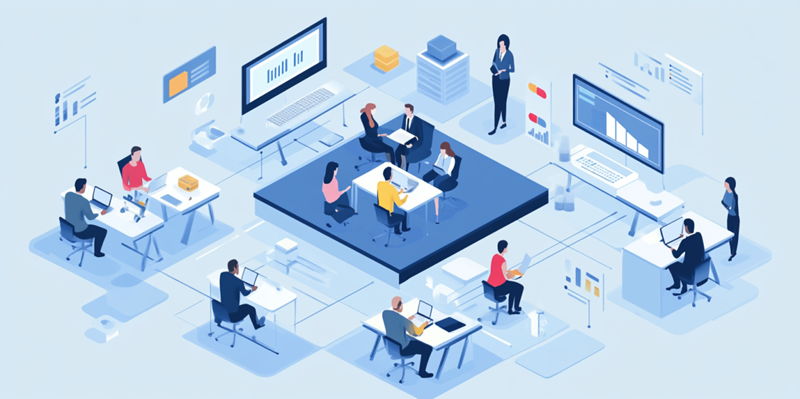Collaboration between Human Resources (HR) and Information Technology (IT) is essential in today’s dynamic technological landscape. Despite the pressing need, many organizations still find themselves grappling with the tech talent shortage and struggling to hire and retain highly skilled employees. Effective cooperation between these two departments can address the tech talent gap more efficiently, leveraging both practical knowledge of critical skills and expertise in employee motivation, market compensation trends, learning approaches, and retention strategies. A more unified approach can navigate the intricacies of talent management and foster an environment conducive to growth and innovation.
Interdepartmental Education
Organizations need to deeply understand the intricacies of HR and IT collaboration to address tech talent shortages effectively. Educating each department on the foundations, values, methods, and goals of the other is crucial for fostering mutual understanding and effective collaboration. Cross-training initiatives shouldn’t be limited to theoretical knowledge; they should also incorporate practical experiences. Such efforts help build empathy, emotional intelligence, and mutual respect among IT and HR personnel. Activities such as joint retreats, gamified environments, and team-building exercises can be particularly effective in helping HR and IT leaders bond and better acquaint themselves with each other’s roles and challenges.
Immersing employees in gamified environments creates a risk-free space for developing and testing soft skills, allowing for growth and understanding. This approach makes learning enjoyable and cultivates a growth mindset within the organization. Employees can appreciate and respect each other’s expertise, leading to a more cohesive work environment where HR and IT professionals can collaborate seamlessly.
Unified Incentives
Encouraging a sense of shared responsibility by aligning Key Performance Indicators (KPIs) is critical for effective HR and IT collaboration. Ensuring that talent management policies align with the organization’s objectives requires establishing clear metrics for pivotal elements. These metrics could include the time required to fill essential tech roles, retention rates of top technologists, progress in skill development, and workforce diversity. By aligning efforts, HR and IT can better contribute to the overall success of the business.
Unified incentives place the focus on collective goals and success rather than individual departmental achievements. This alignment not only fosters collaboration but also ensures that talent management efforts are directly tied to the organization’s strategic goals. By prioritizing shared objectives, HR and IT can work together effectively, promoting a culture of cooperation and collective responsibility that benefits the entire organization.
Interdepartmental Committees
Promoting a culture of cooperation through interdepartmental committees is essential for ongoing collaboration between HR and IT. These committees should be designed to review, adjust, and fine-tune strategies continually to meet the ever-changing needs of the organization and its tech experts. Conducting collaborative retrospectives after campaigns can further enhance understanding and appreciation of each other’s roles.
Through such committees, HR and IT leaders can gain deeper insights into the challenges and opportunities of optimizing the tech talent lifecycle. These committees should serve as vibrant forums for decision-making and contribute to team members’ emotional intelligence development. Ongoing dialogue, knowledge exchange, and cohesive decision-making processes ensure that collaboration becomes a fundamental aspect of the organizational culture, rather than a one-off effort.
Smart Collaboration Platforms
Immersive collaboration platforms can significantly enhance virtual interactions between HR and IT, facilitating data-driven decision-making and fostering mutual understanding. When equipped with Artificial Intelligence (AI), these platforms can analyze data from various sources to provide insights into talent needs, preferences, and trends. This enables HR and IT to align their strategies more effectively.
Real-time translation and sentiment analysis functionalities of these platforms can promote clearer communication and empathy, reducing misunderstandings and building trust between the two departments. By providing a transparent and efficient workflow, these smart collaboration tools can nurture a collaborative environment through shared metrics, leading to an empowered and cohesive workforce.
Proactive Workforce Planning and HR Stress Alleviation
Collaboration between Human Resources (HR) and Information Technology (IT) is vital in today’s rapidly evolving technical environment. Although the demand is high, many companies struggle with a shortage of tech talent, finding it tough to hire and keep highly skilled employees. Effective cooperation between HR and IT departments can better bridge this talent gap. By combining practical knowledge of essential skills with expertise in employee motivation, market compensation trends, learning methods, and retention strategies, these units can create a more cohesive approach to talent management. This unified strategy can help navigate the complexities of acquiring and retaining tech talent.
Furthermore, HR can provide insights into what drives employee satisfaction and engagement, while IT can pinpoint essential technical competencies and anticipate future needs. By aligning goals and working together, these departments can develop and implement more effective recruitment processes, thereby attracting top talent. They can also foster a culture that values continuous learning and professional growth, which is crucial for retention. This collaborative effort not only addresses the immediate tech talent shortfall but also establishes a foundation for sustained growth and innovation. In doing so, companies can build a more adaptable and resilient workforce, ready to meet the challenges of tomorrow.

